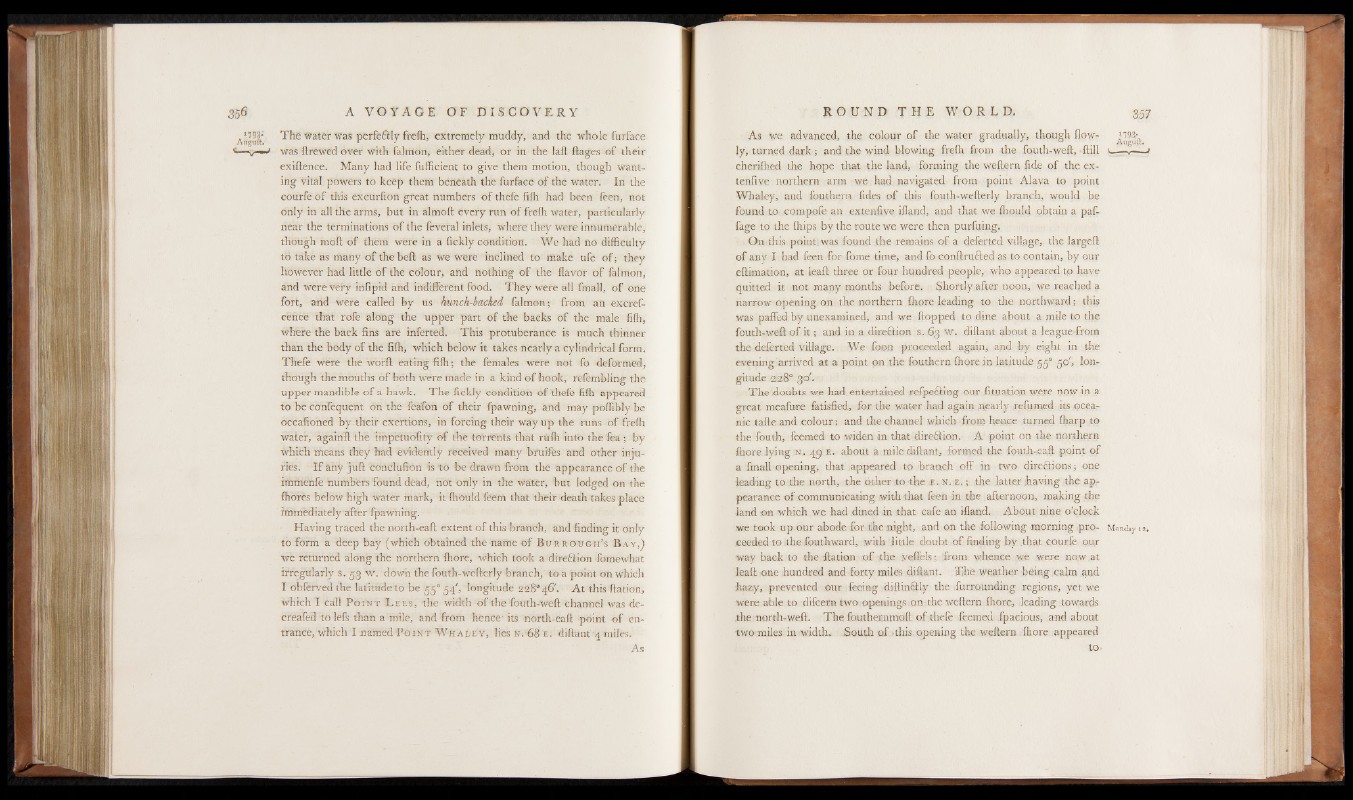
356
Aüguft' The 'Water Was pferfëHIy frefh, extremely muddy, and the whole furface
<— y-—' was ftrewed over with falmon, either dead, or in the laft liages óf their
exiftence. Many had life fufficient to give them motion, though wanting
vital powers to keep them beneath the furface of the water. In the
courfe ó f this excurfion great numbers o f thefe fifh had been feen, not
only in all the arms, but in almoft every run o f frefh water, particularly
near the terminations o f the feveral inlets, where they were innumerable,
though möft o f them weré in a lickly condition. We had no difficulty
to take as many o f the bell as we were inclined to make ufe o f ; they
however had littlé o f the colour, and nothing o f the flavor o f falmon,
and were very infipid and indiffèrent food. They were all final], o f one
fort, and were called by Us hunch-backed falmon ; from an excrèf-
cence that rofe along the upper part o f the backs of the male fifh,
where the back fins are inferted. This protuberance is much thinner
than the body of the fifh, which below it takes nearly a cylindrical form.
Thefe were thé worft eating fifh ; the females were not lb deformed,
though the mouths o f both were made in a kind o f hook, refembling the
upper mandible of a hawk. The lickly condition o f thefe fifh appeared
to be comfequent on the feafon o f their fpawning, and may poffibly be
occafioned by their exertions, in forcing their way up the runs of frefh
water, àgainft the impfctuofity of the torrents that rufh into the fea ; by
Which means they had evidently received many bruife and other injuriés.
I f any juft conclufion is to be drawn from the appearance of the
imiiie'nfe numbers 'found dead, not only in the water, 'bu t lodged on the
fhofès below high water mark, it fhould feem that their death takes place
ftnmbdiately after fpawning.
Having traced the north-éâft extent o f this branch, and finding it only
to form a deep bay (which Obtained the name of B'u r r o u g h ’s B a y ,)
we returned along the northern fhore, which took a direction fomewbat
irregularly s. 53 w . down the fouth-wefterly branch, to a point on which
I öbfërved the latitude to be 55° 54', longitude 2 28“ 46'. A t this Ration,
which I call P oin t T e e s , the width of the Youth-weft channel was d e -
créafed tolefs than a mile, and from hence- its north-eaft point of entrance,
which I named Pot NT W h a iæ -y-, lies N.-68 e . diftant 4 miles.
As
As we advanced, the colour of the water gradually, though flowly,
turned dark; and the wind blowing frelh from the fouth-weft, ftil l 1___— 1
cherifhed the hope that the land, forming the weftern fide of the ex-
tenfive northern arm we had navigated from point Alava to point
Whaley, and fouthern tides of this fouth-wefterly branch, would be
found to compofe an extenfiye ifland, and that we fhould obtain a paf-
fage to the fhips by the route we were then purfuing.
On this point was found the remains of a deferred village, the largeft
of any I had feen for fome time, and fo conftrufted as to contain, by our
eftimation, at leaft three or four hundred people, who appeared tp have
quitted it n.ot many months before. Shortly after noon, we reached a
narrow opening on the northern fhore leading to the northward; this
was pafled by unexamined, and we flopped to dine about a mile to the
fouth-weft o f i t ; and in a direftion s. 63 w . diftant about a Jeaguefrom
the deferted village. We fo.on proceeded again, a;id by eight in the
evening arrived at a point on the fouthern fhore in latitude 55° 50', longitude
2'28° 30'. ■
The doubts we had entertained refpefting our liquation were now in a
great meafore fatisfied, for the water had again nearly refumed its oceanic
tafteand colour; and the channel which from hence turned fharp to
the fouth, feemed to widen in that direction. A point on the northern
fhore lying • « . 49 e . about a mile diftant, formed the foudi-eaft point of
a fmall opening, that appeared to branch off in two direftions; one
leading to the north, the other to the e . n . e. ; the latter having the appearance
of communicating with that feen in the afternoon, making the
■ land on which we had dined in that cafe an ifland. About nine o’clock
we took up.our abode for the night, and on the following morning pro- Monday 12.
needed to ithe fouthward, with little doubt of finding by .that courfe pu,r
way hack to the Ration of the veffels; from whence we were now at
leaft one hundred and forty miles diftant. The weather being calm and
hazy, prevented our feeing diftin&Iy the furrou.nding regions, vet we
were able to difcern two openings ■ on the weftern fhore, leading .towards
the north-weft. The fouthernmoft of thefe feemed fpacious, and about
two miles in width.. South of .this opening the weftern fhore appeared
to>